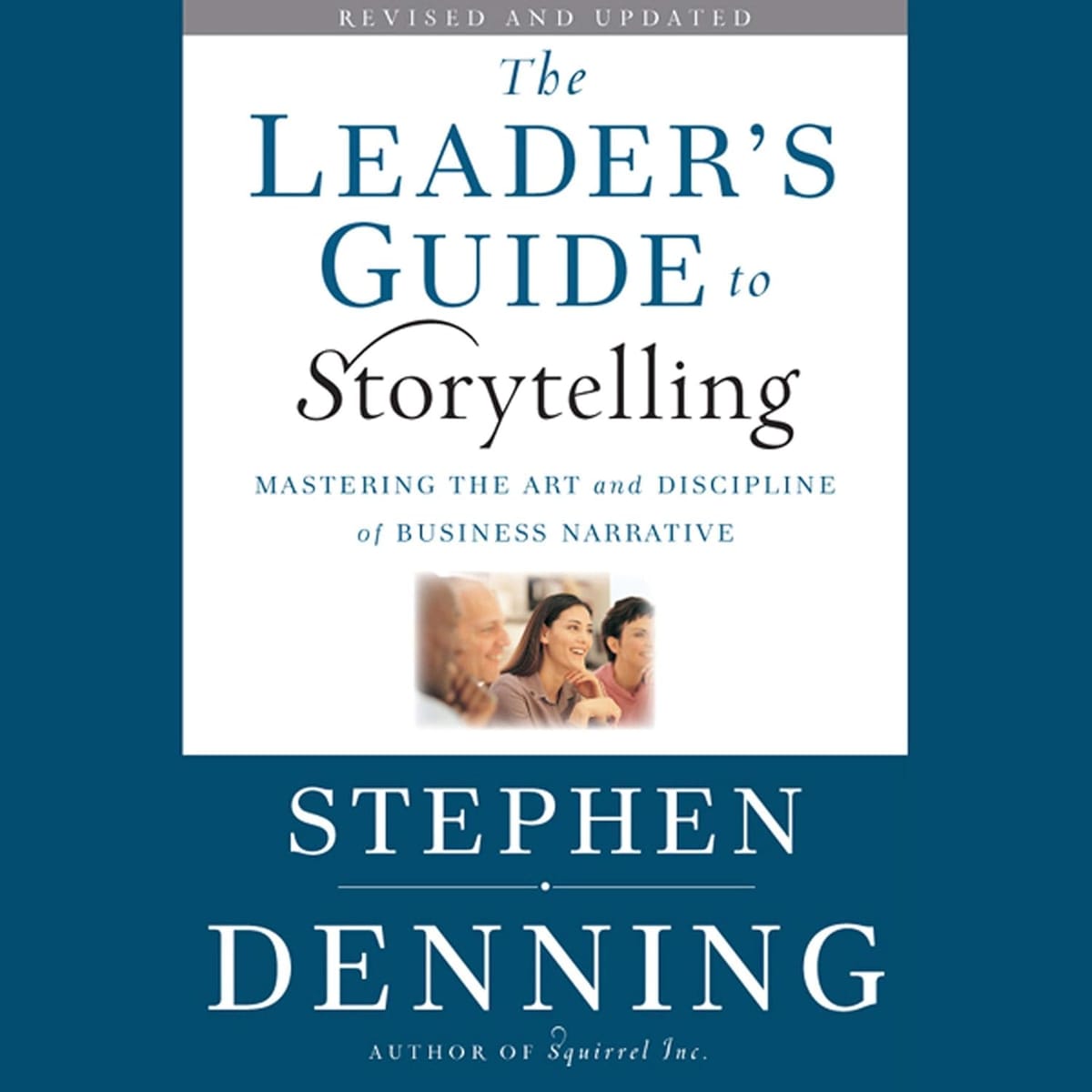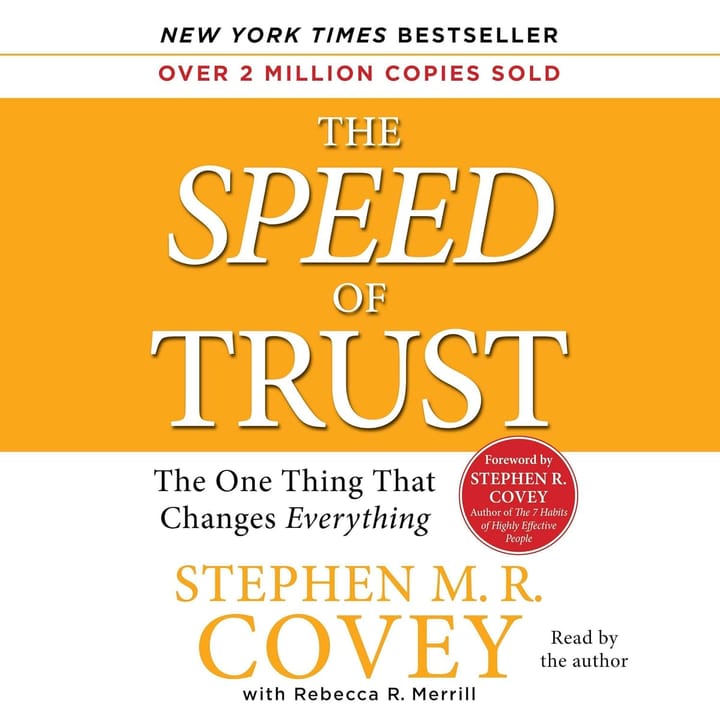Book Summary: The Leader's Guide to Storytelling
Discover how storytelling can transform leadership and communication in Stephen Denning's book The Leader's Guide to Storytelling.

Essential Insights
- Denning emphasizes the importance of storytelling as a powerful tool for effective leadership communication.
- The book provides practical guidance on how to use storytelling to inspire and motivate teams.
- Denning offers examples of successful leaders who have used storytelling to drive organizational change and achieve business goals.
Introduction to The Leader's Guide to Storytelling
The Leader's Guide to Storytelling by Stephen Denning is a compelling exploration of the power of storytelling in leadership. Stephen Denning, a renowned author and former director at the World Bank, brings his extensive experience in organizational storytelling to the forefront in this insightful book. Denning delves into how leaders can harness the art of storytelling to communicate effectively, inspire action, and drive change within their organizations.
This book is invaluable for individuals seeking to enhance their leadership skills and make a lasting impact. By showcasing the profound influence of storytelling in shaping organizational culture and driving strategic initiatives, The Leader's Guide to Storytelling equips readers with practical tools and strategies to become more authentic and inspiring leaders. Whether you are a seasoned executive looking to refine your communication style or a budding leader eager to develop your influence, this book offers a roadmap for leveraging the power of storytelling to cultivate engagement, foster collaboration, and drive results.
Buy "The Leader's Guide to Storytelling" on Amazon
Summary of The Leader's Guide to Storytelling
The Leader's Guide to Storytelling emphasizes the powerful role that narratives play in effective leadership. Stephen Denning argues that storytelling is not merely a tool, but an essential part of leadership practice. He presents storytelling as a means to inspire, engage, and create an emotional connection with team members, which can enhance communication and foster a shared vision. By illustrating how stories can influence action and behavior, the book reinforces that storytelling is a valuable skill for leaders aiming to motivate and galvanize their teams.
One of the standout contributions of this book is its practical approach to storytelling in the workplace. Denning provides a variety of real-world examples, illustrating different types of stories that can be used to address specific business challenges. He emphasizes not just the importance of storytelling, but also offers techniques for crafting and delivering stories that resonate with diverse audiences. This actionable guidance makes the book particularly useful for leaders seeking to harness the art of storytelling to evoke change and build trust within their organizations.
Throughout the book, Denning stresses that effective storytelling can lead to innovation, collaboration, and improved morale within teams. He encourages leaders to find their authentic voice and share personal stories that reflect their values and vision. As readers explore the insights presented, they will discover that storytelling is more than just entertainment; it is a means to connect, inspire, and lead in a meaningful way. These ideas set the foundation for understanding how leaders can cultivate their storytelling skills to enhance their impact on both individuals and organizations.
Key Lessons From The Leader's Guide to Storytelling
The Power of Storytelling in Leadership
In The Leader's Guide to Storytelling, Stephen Denning emphasizes the importance of storytelling as a vital tool for leaders. By using stories, leaders can convey complex ideas in a relatable manner, making it easier for their teams to grasp the vision and mission of the organization. This approach not only facilitates understanding but also fosters a sense of belonging among team members, as they are able to connect emotionally with the narrative.
One notable example from the book highlights a leader who transformed his organization by weaving stories around its history and values. By sharing personal anecdotes that resonated with employees, he breathed new life into the company's culture. This not only energized the staff but also aligned them with the organization's goals, demonstrating that shared stories can create unity and a common purpose.
The take-home message here is that leadership is not just about directive communication but involves engaging others emotionally. For readers, this realization holds the potential to change their approach to leadership. By embracing storytelling, they can cultivate deeper connections with their teams, resulting in a motivated workforce and a more cohesive organizational culture.
Building Trust Through Authenticity
Denning illustrates the significance of authenticity in storytelling, pointing out that genuine stories are crucial for building trust. Leaders who share their authentic experiences—both successes and failures—foster a sense of reliability. When team members feel that their leaders are open and honest, they are more likely to engage and invest in the collective mission of the organization.
A compelling example from the book features a leader who candidly discusses past mistakes while outlining the lessons learned. This vulnerability encouraged employees to share their own challenges without fear of judgment, leading to a more open workplace culture. Such authenticity not only strengthens relationships but also promotes a culture of learning and resilience.
The Role of Narrative in Change Management
Change is an inevitable part of any organization, and Denning highlights storytelling as a powerful mechanism for facilitating smooth transitions. When leaders articulate the reasons for change through compelling narratives, they can alleviate resistance and motivate employees to embrace new directions. Stories can clarify the vision behind a change initiative, thereby making it more palatable and relatable to team members.
For instance, Denning recounts a scenario where a leader successfully implemented changes by creating a narrative around the potential benefits for employees and customers alike. By framing the change as an exciting opportunity rather than an upheaval, he sparked enthusiasm and commitment among his team. This narrative approach diminishes apprehension and encourages a collaborative spirit during periods of uncertainty.
This lesson inspires readers to recognize the potential of storytelling in their own change initiatives. By harnessing the power of narrative, they can guide their teams through transitions with less friction and more engagement. Ultimately, this leads to a resilient organization that adapts better to new challenges and opportunities.
Engaging Stakeholders Through Relatable Narratives
Denning emphasizes that effective storytelling goes beyond internal communications; it is also essential for engaging external stakeholders. By crafting narratives that resonate with customers, partners, and the broader community, leaders can create deeper connections that enhance loyalty and bolster brand credibility. A well-told story can humanize an organization, making it more approachable and relatable to its audience.
An example presented in the book involves a company that successfully revamped its brand identity by sharing stories of its impact on customers’ lives. This strategy not only improved customer engagement but also garnered positive feedback and loyalty. By focusing on real experiences and emotions, the company cultivated a brand narrative that stood out in a competitive market.
The significance of this lesson lies in its ability to inspire leaders to think beyond traditional business paradigms. By engaging stakeholders through relatable narratives, readers can elevate their organizations’ visibility and strengthen relationships, ultimately fostering a culture of trust and collaboration. This shift can unlock new opportunities for growth and partnership, driving long-term success.
Application Ideas for The Leader's Guide to Storytelling
Craft Your Personal Narrative
The first step derived from the teachings of the book is to develop your own personal narrative. A strong personal story connects your values, experiences, and vision, making it easier for others to understand who you are and what you stand for. By identifying key moments in your life—such as challenges you've overcome or lessons you've learned—you can create a cohesive narrative that expresses your leadership journey.
To implement this in daily life, take time to reflect on your career and personal milestones. Write a brief account of your experiences that highlight your skills, challenges, and values. Sharing this narrative allows others to connect with you on a deeper level, fostering trust and understanding. Allocate time each week for storytelling practice, refining your narrative through feedback from peers or mentors to make it more compelling and relatable.
An effective way to use your personal narrative is during networking events or meetings. Having your story prepared enables you to share relevant experiences that demonstrate your leadership qualities. This approach not only builds rapport but also strengthens your influence in the group. To simplify this process, create a one-minute elevator pitch version of your story, focusing on the most impactful elements, which can be expanded upon as conversations develop.
Engage Through Empathy
An essential component of storytelling in leadership is empathy. By understanding the perspectives and experiences of others, you can craft narratives that resonate deeply. Start by actively listening to your team members or colleagues during conversations. This creates a genuine connection and paves the way for more meaningful dialogue. Make a habit of asking open-ended questions that invite others to share their thoughts and feelings.
Use this empathetic approach when addressing challenges within your team. Instead of simply presenting data or directives, share stories that illustrate how similar situations were overcome in the past. This not only reinforces your message but also encourages others to engage and contribute their own experiences. As a practical application, create a safe environment where team members feel comfortable sharing their thoughts. Establish regular check-ins or informal gatherings conducive to open communication.
Utilize Stories for Change
Measure the Impact of Your Stories
Your implementation strategy could involve conducting regular surveys to gauge how well your stories are received. This allows you to gather valuable feedback and adjust your storytelling approach as needed. Keeping track of responses over time can help you identify trends and shifts in audience perception, resulting in improved storytelling techniques and stronger connections.
A practical example can be found in organizations that have successfully utilized storytelling to enhance their culture. By measuring engagement levels before and after introducing storytelling sessions, leaders can quantify their impact on teamwork and morale. To make this process smoother, consider utilizing simple online tools that facilitate data collection and analysis, ensuring the impact of your storytelling efforts is clear and actionable.
Concluding Thoughts
The Leader's Guide to Storytelling by Stephen Denning presents a compelling case for the essential role of storytelling in effective leadership. Throughout the article, we explored how narratives can inspire and engage team members, creating emotional connections that enhance communication and build a shared vision. Denning emphasizes that storytelling is not just a useful tool but an indispensable part of leadership practice that can motivate and galvanize teams.
A significant aspect of the book is its practical approach, filled with real-world examples that demonstrate how storytelling can be used to tackle specific business challenges. Readers are provided with actionable techniques for crafting and delivering stories that resonate with diverse audiences. This guidance is invaluable for leaders aiming to harness storytelling to evoke change and cultivate trust within their organizations. The article also highlighted the importance of authenticity in storytelling and how it helps build trust. When leaders share genuine experiences, including their failures, they foster a culture of openness and vulnerability. This authenticity encourages employees to engage and share their own challenges, resulting in a more resilient and innovative workplace.
Change management is another critical theme in the book, where Denning illustrates how storytelling can reduce resistance and promote engagement during transitions. By framing changes within compelling narratives, leaders can clarify the vision behind initiatives and inspire commitment from their teams. Moreover, storytelling extends beyond internal communications to engage external stakeholders. By sharing relatable narratives, organizations can enhance customer loyalty and brand credibility. Denning's examples reinforce the idea that well-crafted stories can humanize an organization and create deeper connections with its audience. To apply these concepts, the article encourages readers to craft their personal narratives, engage through empathy, and utilize storytelling for change. By embracing these practices, leaders can enhance their effectiveness and foster stronger connections with their teams.
The value of The Leader's Guide to Storytelling is evident in its insightful exploration of how stories can enhance leadership effectiveness. Readers are encouraged to further explore this work to unlock their potential in storytelling and leadership. As you move forward, consider how you can implement the lessons and strategies discussed. Take action by refining your personal narrative, practicing empathetic communication, and using stories to facilitate change within your organization. Embrace the power of storytelling, and you will inspire and connect with others on a deeper level, driving success in your leadership journey.
Related Topics
- Leadership - Examining the characteristics and skills necessary to effectively lead a team or organization.
- Communication - Exploring different methods of conveying information and building connections with others.
- Change management - Understanding how storytelling can be used to facilitate and guide organizational change processes.
- Organizational culture - Analyzing the role of storytelling in shaping and reinforcing the values and beliefs of a workplace.
- Emotional intelligence - Recognizing and managing emotions in oneself and others to enhance leadership effectiveness.
- Employee engagement - Investigating how storytelling can impact employee motivation, loyalty, and overall job satisfaction.
Reflection & Discussion Questions
Reflection is a powerful tool for personal growth and leadership development. Whether you're exploring your own experiences or engaging in thoughtful group discussion or team training, reflection questions help uncover new insights, clarify values, and inspire meaningful action. Below are questions designed to deepen your understanding of the concepts taught in The Leader's Guide to Storytelling, and facilitate constructive conversations with your team or group.
- How can storytelling be an essential part of effective leadership practice?
- What role do narratives play in inspiring, engaging, and creating emotional connections with team members?
- What techniques does the book offer for crafting and delivering stories that resonate with diverse audiences?
- How can storytelling lead to innovation, collaboration, and improved morale within teams?
- What is the significance of authenticity in storytelling for building trust with team members?
- How can sharing personal stories that reflect values and vision impact an organization's culture?
- How does storytelling facilitate smooth transitions and alleviate resistance to change within an organization?
- What strategies can leaders use to engage external stakeholders through relatable narratives?
- How can crafting a personal narrative help leaders connect with team members and foster trust?
- What role does empathy play in effective storytelling in leadership practice?
- How can leaders utilize stories to drive change within an organization?
- Why is it important to measure the impact of storytelling on team engagement and individual performance?
- How can leaders identify specific objectives related to their narratives to drive results?
- What can leaders learn from organizations that have successfully utilized storytelling to enhance their culture?
- What key takeaways can leaders glean from the book to improve their storytelling skills and enhance their impact on individuals and organizations?
Recommended Reading
Below are a few recommended books related to concepts taught in The Leader's Guide to Storytelling.
- Storyworthy: Engage, Teach, Persuade, and Change Your Life Through the Power of Storytelling by Matthew Dicks. A guide to crafting and delivering compelling stories for personal and professional growth.
- The Storytelling Animal: How Stories Make Us Human by Jonathan Gottschall. Explores the role of storytelling in human evolution, psychology, and culture.
- Lead with a Story: A Guide to Crafting Business Narratives that Captivate, Convince, and Inspire by Paul Smith. Provides practical advice for using storytelling as a leadership tool in business settings.
Frequently Asked Questions
What is the importance of storytelling in leadership?
Storytelling is crucial in leadership because it is a powerful tool for communicating vision, inspiring action, and building strong relationships with team members. Through storytelling, leaders can convey complex ideas in a simple and memorable way, making it easier for their messages to resonate and be understood by others. Additionally, storytelling allows leaders to connect with their audience on an emotional level, fostering trust and loyalty.
How can storytelling be used to build trust in an organization?
One way storytelling can be used to build trust in an organization is by sharing personal experiences and anecdotes that humanize the leadership team and create a sense of connection with employees. When leaders are open and vulnerable in sharing their own stories, it can help to break down barriers and foster trust among team members. Additionally, stories can be used to communicate the organization's values, mission, and vision in a way that resonates with employees and helps to reinforce a sense of unity and purpose.
How can storytelling be used to shift organizational culture?
Storytelling can be used to convey new values, beliefs, and norms in a way that is engaging and impactful. By sharing stories that embody the desired culture and highlighting positive behaviors or outcomes, leaders can shape the collective mindset of the organization. Storytelling can also help create a sense of shared identity and purpose among employees, fostering a culture of collaboration and innovation.
How can I make storytelling a regular habit?
To make storytelling a regular habit, consider starting small by incorporating stories into your daily communications and presentations. Practice sharing anecdotes during team meetings or in one-on-one conversations with colleagues. Additionally, set aside dedicated time in your schedule to work on crafting and refining new stories to share. By consistently integrating storytelling into your professional interactions, you will become more comfortable and skilled in this powerful communication technique.
Buy "The Leader's Guide to Storytelling" on Amazon
Affiliate Disclaimer
Some of the links on this website may be affiliate links. This means that, at no additional cost to you, we may earn a commission if you click through and make a purchase. Your support through these affiliate links helps sustain and improve the quality of the content we provide.



